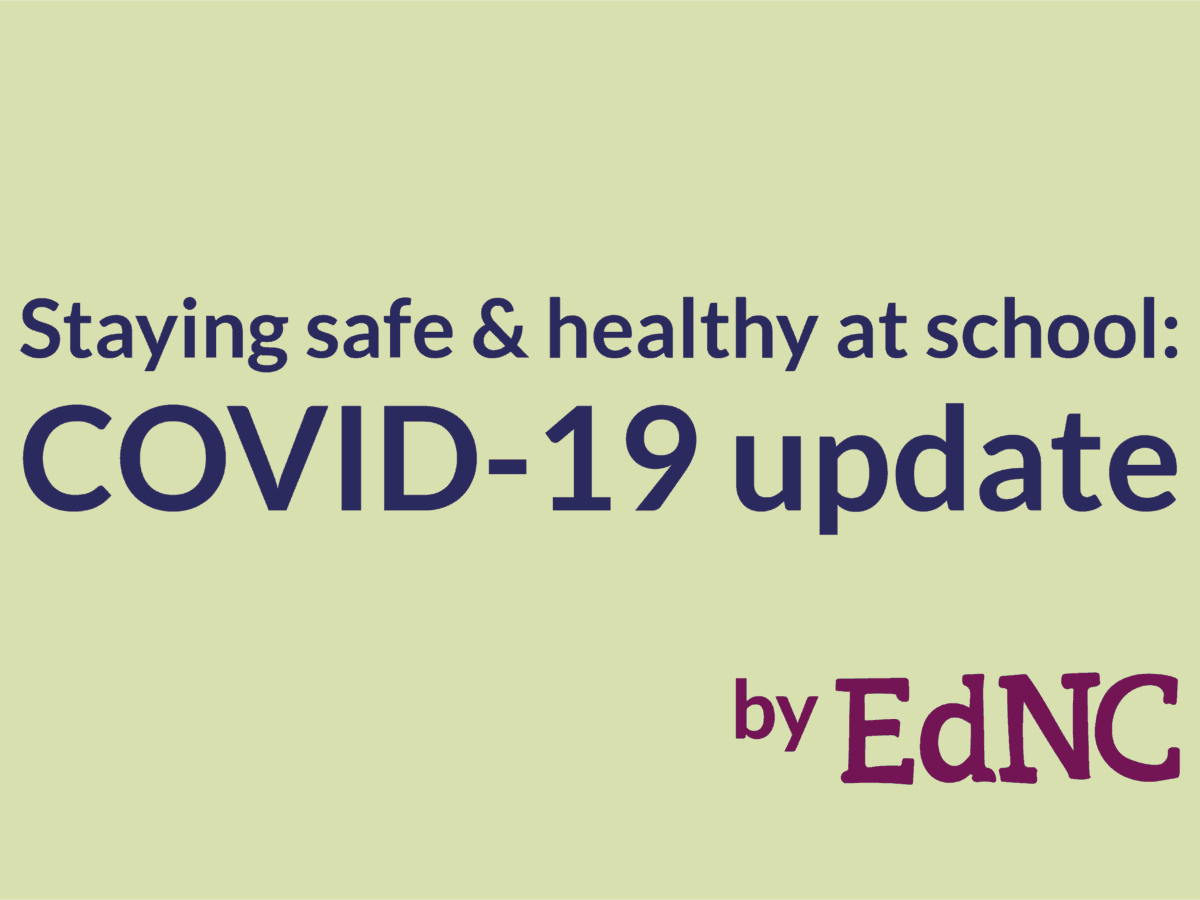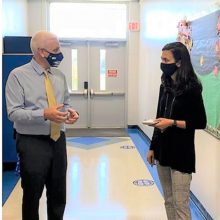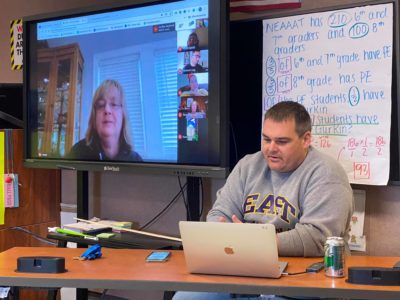

Two weeks ago, district-level discussions about the impact of COVID-19 on Wilson County Public Schools included things like cancelling after school activities and sporting events. That was until Saturday, March 14, when Gov. Roy Cooper announced a statewide closure of all K-12 public schools for at least two weeks — a closure that has since been extended through May 15.
For Mary-Catherine Talton, director of child nutrition services for Wilson County Public Schools, that announcement felt like “a light switch got flipped on.” Talton and her team of office staff, site managers, and supervisors sprung into action to create a comprehensive plan for continuing to offer breakfast and lunch while school buildings were closed.
First, they visited schools across the district, taking inventory of the supplies and food on hand. They considered which deliveries would need to be canceled and which deliveries still needed to come in.
“At that point, it was figuring out which way was up,” said Talton.
– 26 schools
– 10,980 students
– Race/ethnicity: 44% black, 29% white, 27% other
– Percent of students eligible for free- or reduced-price meals: 48%
– Average daily lunches served: 6,398
Once it was determined which schools would serve as meal sites, her team loaded into delivery vans and trucks and transferred food supplies from schools that wouldn’t be operating as meal sites to those that would.
Then there was the coordination of how to use the districts’ yellow school buses to deliver meals across the district. Talton was in and out of district leadership meetings, including multiple visits to the district’s bus garage to discuss logistics. The districts’ transportation team provided insight into what the bus stops look like, and Talton provided insight into how they would actually load meals onto buses and serve them.
A combination of rapid communication and cross-department collaboration resulted in a robust plan to feed all students under age 18 in the district. For no cost, families can pick up both a lunch for that day and a breakfast for the following day for any child under 18, and the child doesn’t have to be present. In fact, the child doesn’t have to be enrolled in a Wilson County school at all — they could be homeschooled or attend a private school and would still be eligible to receive these meals.
Currently, nine schools are serving as meal sites from noon to 1:30 p.m. each weekday, providing curbside pickup or walk up service for meals. Additionally, 17 bus stops and schools are providing meal pickup from buses that are parked at each site for a certain time frame. Hourly employees such as teacher assistants and bus drivers are involved in delivering and handing out the meals, providing them with hours when they might otherwise have been out of work.
Talton said these sites were strategically chosen by using the area eligibility map from the US Department of Agriculture to ensure they were spread across the district in a way that would meet the needs of all students. And the list of sites is fluid — if Talton hears of certain areas of the district that are being missed, she plans to adjust the site list accordingly to reach those students.
For every meal served, the district’s child nutrition department receives a federal reimbursement, and that is the sole source of revenue that Talton has to continue providing meals while schools are closed. The district’s child nutrition staff continue to be paid, but Talton said they are only serving about one-third of the meals they would usually serve on a normal school day.
While revenue has significantly decreased, Talton said expenditures remain roughly the same as they were before schools closed. But, that doesn’t mean free school meals are going away.
“We’re going to do what we have to do to feed our students,” she said. “While this is going to be a very hard time for all of us, our students remain our number one priority.”
If faced with a similar situation in the future, Talton said she would focus on having a plan in place ahead of time and knowing exactly what questions to ask. How many of her staff members are willing and able to work during this time? How many buses will the district be able to utilize to serve meals? How should the child nutrition department go about partnering with other departments, whether it be transportation or instruction?
“I think we have gone into this with a lot of questions. In the event that there is a next time … the best way to be prepared is to know what questions you need answered ahead of time,” said Talton.
Note: Shortly after this conversation with Talton, Gov. Cooper announced financial flexibility and relief to address unanticipated costs arising from COVID-19, including school nutrition. A $50 million flexible allotment for all public schools will be established at the Department of Public Instruction.
Are you looking for free meals for kids ages 18 and under? Here’s how to find them.
– Text FOODNC to 877-877 to get a text with sites nearby.
– Use the map tool at http://nokidhungrync.org/covid19.
– Visit this document for updates from school districts and community partners serving meals.
– Check your school and/or district’s website, social media, or other communications.
A closer look at the policies on school meals during COVID-19
Two days before Gov. Cooper first announced closure of all North Carolina public schools due to COVID-19, the Department of Public Instruction (DPI) School Nutrition Division received waiver approval from the US Department of Agriculture that allows school closed due to COVID-19 to serve meals to students using the National School Lunch Program’s Seamless Summer Option or through the Summer Food Service Program.
That means that both school districts and community sponsors (i.e. faith organizations, YMCA’s, etc.) can offer federally-reimbursed school meals during this time — as long as they are first approved to do so by DPI.
Importantly, the waiver allows these meals to be served in non-congregate settings (i.e. picked up curbside, delivered via school bus) in order to support social distancing guidelines. Usually, under the Summer Food Service Program guidelines, meals have to be consumed where they are served, like in a cafeteria or public park, and they can’t be passed off to adults. Talton highlighted this flexibility as a crucial part to serving meals safely during COVID-19 — students can receive free meals without ever leaving their home or safe location.
And while it isn’t mandatory that districts provide meals while schools are closed, DPI is encouraging school districts and community organizations to “support the needs of economically disadvantaged children for whom there may be limited access to food during extended periods of school closure.” DPI also released this memo on preparing and providing meals safely during COVID-19.
If you’re curious about what districts across the state are doing, browse this document compiled by No Kid Hungry North Carolina. The following information is sourced from a school meals during COVID-19 Q&A document released by DPI.
Who can receive meals?
The waiver targets children who attend schools that are closed due to COVID-19, but in eligible areas, meals can be served to all children under 18 in a household if at least one child attends a school that has been closed.
Additionally, parents, caretakers, and siblings can pick up meals for their child/sibling, as long as the meals site has a way of confirming they have an enrolled child/sibling enrolled in the school.
Where can meals be served?
For schools where 50% or more of students are eligible for free- or reduced-price meals, distribution methods can focus on providing meals to all students from that school. For schools where less than 50% of students are eligible for free- or reduced-price meals, distribution methods must more directly target households of children who are eligible for those meals.
What food can be offered at meal sites?
Up to two meals or one meal and one snack can be offered each day. Sites can serve breakfast, lunch, snack, or supper in any combination except lunch and supper. For example, some meal sites are allowing students to pickup both a lunch for that day and a breakfast for the following day. DPI may approve a distribution approach that includes meals for multiple days for up to seven days per week. Such distribution requires prior approval of DPI.
All meals have to follow the regular menu requirements of the National School Lunch Program’s Seamless Summer Option or the Summer Food Service Program, depending on which program the site is utilizing. That means that each meal must be fully reimbursable and include all required components, including milk.
However, DPI is offering certain districts waivers to ease these meal requirements. For example, Wilson County Public Schools received a waiver to not serve milk with their meals — something that Talton only plans to use if there is a shortage of milk. Talton said the district isn’t having trouble getting the food they need at this point, but there have been delays in getting certain foods and supplies.
Behind the Story
The photos that previously appeared in this article were removed on March 27 because concerns were raised about the images relative to the CDC’s guidelines on safety protocols during COVID-19.




